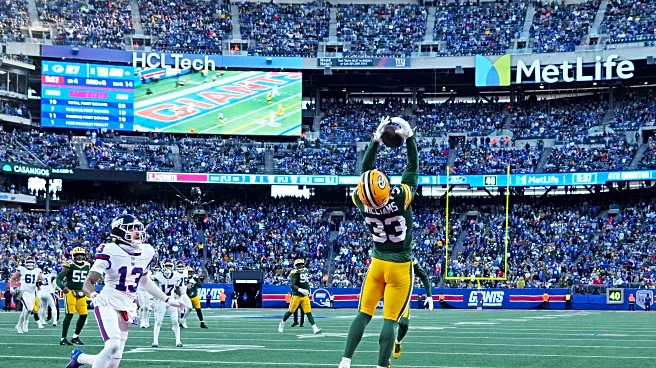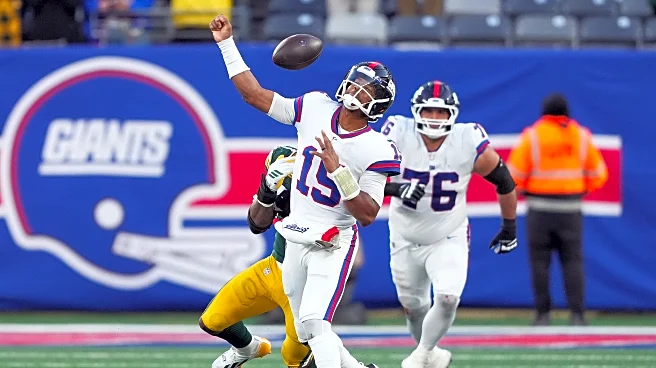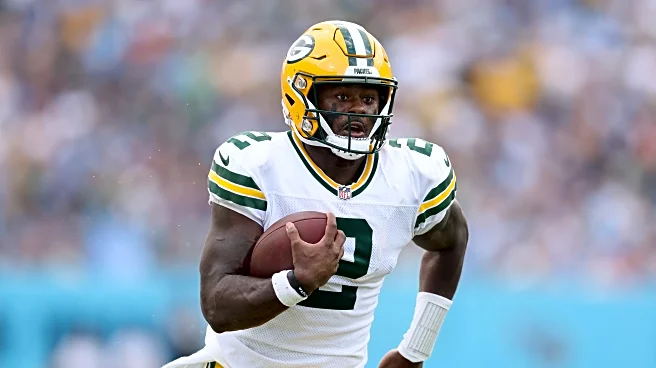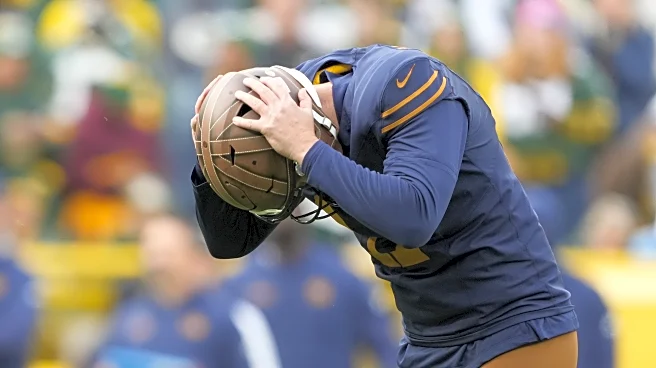There were a bunch of injuries in Sunday’s game against the New York Giants, so there’s probably not going to be a Green Bay Packers depth chart update as long as this one for the remainder of the season.
We’ll take you through what’s changed with this Packers roster, position-by-position, based on what the team did this weekend.
As always, the snap counts below do not include plays with pre-snap penalties (like false starts), spikes or kneel, but they do include plays with post-snap penalties (like holding). Cells in red mean that a player was unable to play the game due to injury. Cells in yellow mean that a player was unable to finish the game due to injury. Cells in black mean that a player was a healthy scratch in the game.
Offensive Personnel

So much for that short-lived 11-personnel revolution in Green Bay. When tight end Tucker Kraft went down with his ACL tear, many expected the Packers to live in three-receiver sets for the remainder of the season. While that was the case in Week 9 and Week 10, the games in which Green Bay played their highest rate of 11 personnel looks (71 percent and 81 percent) all season, the script flipped this past week.
With the emergence of tight end Josh Whyle, who was brought up to the active roster from the practice squad in Week 10, and the usage of offensive lineman Darian Kinnard at tight end in six-lineman looks, the Packers played just 53 percent of their offensive snaps against the Giants out of three-receiver sets. That’s the second-highest rate of multiple-back or multiple-end looks that the team has played since Week 2.
At the end of the day, this Green Bay team wants to play bully ball. They want to be heavy. They want to run the ball. Even a season-ending injury to Kraft won’t stop them from their long-term goal. It’s how they’ve built this team.
Quarterbacks

Hey, Malik Willis finally got some action this week when Jordan Love went out for half a series with an injury to his left shoulder. Willis went two of two for six yards and a score, along with a carry for 16 yards, to finish that drive.
Some were speculating whether Willis was actually trying to throw the ball to Romeo Doubs on his touchdown, instead of Christian Watson, but head coach Matt LaFleur told the press on Monday that Willis said that he didn’t even see Romeo when he made the throw. Good for Watson for pulling that one down.
Running Backs

Josh Jacobs left the Giants game after the Packers’ first touchdown drive, and it’s uncertain whether he’ll be able to play this week against the Minnesota Vikings. If Jacobs is out, expect a healthy dosage of Emanuel Wilson, who out-snapped Chris Brooks 35-5, despite the Jacobs injury.
Those Brooks snaps also include when he was in the backfield as a fullback for another back, a common way he’s been used this year. In the four snaps as a lone back this week, the Packers completed three passes, and Brooks had a run for eight yards. One of the pass plays included a clinic-worthy pass protection rep from Brooks on a third-and-long conversion.
Good things happen when the team plays Brooks, dating back to the season opener. I wish the team would use him more.
In other backfield news, Josh Whyle has played five snaps as a fullback in the last two weeks, probably the most of a tight end since the team moved on from Josiah Deguara. Clearly, they like that role for their new tight end.
Receivers


The Packers did something interesting this week. In the team’s two most recent losses against the Carolina Panthers and Philadelphia Eagles, the one area of the field that both teams allow to be the softest was the intermediate sidelines, an area of the field that Matt LaFleur hasn’t targeted often while in Green Bay. Usually, LaFleur likes to throw over the middle in the intermediate range, like on crossers or digs, rather than to the outside on shorter corner routes or deeper out routes.
That changed this week, which you can see clearly on Jordan Love’s spray chart.
The way the Packers got into those looks, though, was by playing running backs and tight ends as outside receivers, essentially using them as the players on run-off routes, while playing their more premium pass-catching targets in the slot on those plays. That’s why you’ll see the bump in slot rate for Romeo Doubs and Christian Watson, despite Malik Heath (outside receiver) being out and Matthew Golden (who has mostly been playing the slot since Watson returned from injury) being in.
In total, Green Bay played a tight end or running back as an outside receiver 16.4 percent of the time, which is about double the Packers’ season-long average this year. It’s also a single-game high for Green Bay this season. Specifically, they did it on these types of intermediate sideline passing plays.
By the way, I still think that the Packers’ receiver room will feature Doubs (outside), Watson (outside) and Jayden Reed (slot) the most, when Reed is back into the mix. When Reed is full-force, Matthew Golden and Dontayvion Wicks will basically share a backup receiver role, with both of them mixing into the game as outside threats and slot receivers when the starters need a breather. As the season continues, I believe that Golden’s snap counts will only decrease further.
Tight Ends

Last week, Luke Musgrave was the replacement starter for Tucker Kraft. This week, John FitzPatrick more than doubled Musgrave’s snaps played. That seems to be an accident, though, as head coach Matt LaFleur said in his Monday press conference that he told his staff that Musgrave needs to be playing more snaps. Notably, Musgrave only played two snaps in the entire second half against the Giants.
If you want to voice your opinion on who you would rather start at tight end, we have an open thread for you to discuss this.
Over the last two weeks, offensive lineman Darian Kinnard has played 10 snaps as a tight end for the Packers in their six-linemen looks. Receiver Christian Watson has also played nine snaps in a tight end alignment over the last two weeks, after only playing two in his first two weeks back on the active roster. The team is adapting to the post-Kraft world that they’ve found themselves in.
Offensive Linemen





Outside of the three snaps that Darian Kinnard came in to play for an injured Zach Tom, the Packers’ preferred starting offensive line of Rasheed Walker, Aaron Banks, Sean Rhyan, Jordan Morgan and Tom (left to right) played all of their snaps together. Sunday’s action was another example of the team clearly having different backup tackles, by the way. Since Week 4, Kinnard has been the backup right tackle, while Anthony Belton has been the team’s backup left tackle. Expect that to continue.
I’m not sure who would be the next man up at guard or center, but I’m assuming the guard would be Kinnard (who has done this before in Philadelphia) and the center would be Jacob Monk, but that’s just a shot in the dark. I could easily see a world where Monk is the backup at all three interior offensive line spots. He has yet to play a snap this season after starting the regular season on the injured reserve with a hamstring issue.
Rhyan had some bad snaps in his first game as a starter at center. A lot of this was explained away by the team as problems with the wind in MetLife Stadium on Sunday. Keep an eye on that moving forward, though, because I’m not sure how often I’ve heard wind being an excuse for poor shotgun snaps. That’s a new one to me.
Defensive Personnel

For the most part, the Packers match their defensive personnel to the offense’s personnel, meaning that if Green Bay is facing three receivers, they’ll play their nickel packages. If they only get two receivers, they’ll play their base defense.
Over the last two weeks, the Packers have had to play a LOT of base defense. In Weeks 10 and 11, they’ve only been able to play a lighter personnel than their 4-3 base defense 54 percent of the time. From Week 1 through Week 9, Green Bay was playing lighter subpackages 73 percent of the time.
In this game, specifically, I think the Giants were trying to get that third linebacker on the field because Isaiah McDuffie, typically the team’s third linebacker, was playing the Mike linebacker spot once Quay Walker left action with a stinger, forcing Ty’Ron Hopper to fill in as the third linebacker.
Look for teams to keep trying Hopper if Walker is out for any significant time. He’s a bit of an unknown.
Defensive Ends

Rashan Gary’s time in Green Bay might be over after this season. The Packers would save north of $11 million of cap space immediately if they can trade or release him before June 1st. Over the first eight games of the season, Micah Parsons only outpaced Gary’s snaps by just 4 percent. Over the last two games, though, Parsons has played 36 percent more snaps than Gary.
The team might have been trying to keep Gary fresh after he was unable to produce much early on in the season, outside of the cleanup sacks created by Micah Parsons’ pressures. The tune down of snaps, to the benefit of Kingsley Enagbare, hasn’t worked, though, as Gary is still on pace to have the worst pass-rushing season in his NFL career.
Warren Brinson’s one snap at end this week came in a goal-line look where he was one of five defensive tackles on the field. It’s his first snap at end this year, with the team usually electing to play Colby Wooden (early downs) and Karl Brooks (Cheetah packages) at end if they’re going to field a tackle on the edge.
Defensive Tackles

In the three other games that both Nazir Stackhouse and Warren Brinson have been active for, Brinson had out-snapped Stackhouse 63 to 24. This flipped this week, though, when Stackhouse played 13 snaps to Brinson’s 5. Stackhouse, currently, is the true fourth tackle in Green Bay for the first time.
Since Lukas Van Ness’ injury, the Packers have leaned on Micah Parsons playing at defensive tackle in the team’s Cheetah packages with three defensive ends on the field at the same time. Whenever Van Ness comes back, expect Parsons to start playing outside again a little more.
Linebackers

Again, injuries had an impact at this position. Quay Walker, the starting middle linebacker of the team, left the game with a stinger, pushing Isaiah McDuffie into the position and Ty’Ron Hopper into the third linebacker role. Safety Xavier McKinney’s two snaps at linebacker were in the team’s goal-line packages, where the Packers gave up just one yard in two plays. Unfortunately, the Giants only needed one yard to score a touchdown in that situation.
The fact that the team played McKinney at linebacker in that position shows that they would rather have him playing that role than Kristian Welch, who is really more of a special teams player than a defender. The same was true with Nick Niemann, before he was placed on the injured reserve.
The situation is prickly, depending on Walker’s status. Basically, the Packers have three healthy true linebackers, even though they are playing so much 4-3 defense right now. They need a break in case of emergency option, if they aren’t comfortable with Welch having to play snaps down the stretch if there’s another injury.
Cornerbacks

All of the cornerback snaps this week went to Keisean Nixon and Carrington Valentine, which shouldn’t be surprising. What might be a little surprising to folks, though, is that Nixon and Valentine are both performing above the NFL average.
In terms of yards per coverage snap, Valentine ranks 20th in the league (firmly CB1 territory) and Nixon ranks 34th (borderline CB1). Only three teams, the San Francisco 49ers, Seattle Seahawks and Miami Dolphins, have two cornerbacks who have played as much as the Packers’ pairing and have been giving up fewer yards per coverage snap. This staff will attempt to force Nate Hobbs (ranked 56th) back into the lineup whenever he’s healthy, but the top two cornerbacks for Green Bay are pretty clear.
Slot Defenders

With Nate Hobbs out with a knee injury, it’s still all Javon Bullard in the slot. The one rep that Kitan Oladapo got in the slot this week was on the end-of-game play in prevent defense, where the Packers played three high safeties and double slots, the same as Oladapo’s only other slot rep in 2025 — which came last week.
Safeties

From Week 2 to Week 6, Xavier McKinney and Evan Williams took every snap at safety for the Packers. Since Week 7, though, Green Bay has been giving Javon Bullard some opportunities to play 4-3 safety, when he’s not playing the nickel in their subpackages.
Bad things happen when Bullard is at safety. Almost every time.
Against the Carolina Panthers, the Packers allowed the only two touchdowns of the day on the two drives that Bullard played safety. Against the Giants, New York also scored on the lone Bullard drive.
Evan Williams should never be off the field. I would understand this more if it were situational, like if the team believed that Bullard was a better run-stopper, but it’s really just a drive-by-drive thing. Evan Williams should never be off the field.
Have I mentioned that Evan Williams should never be off the field? Bad things happen when Evan Williams is off the field. Evan Williams should never be off the field.












